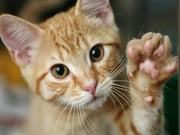Scientists Discover Secrets of the Cat's Purr
By Cara Murez HealthDay Reporter
MONDAY, Oct. 9, 2023 (HealthDay News) -- Anyone with a cat knows the calm, low rumble of purring, but how does such a small animal make such a low sound?
New research suggests it boils down to a pad embedded in feline vocal cord folds.
That’s different than previously thought, which was that purring happened through a special mechanism, with cyclical contraction and relaxation of the muscles in the vocal folds within the larynx, and that it required constant control from the brain.
“Anatomical investigations revealed a unique ‘pad’ within the cats’ vocal folds that may explain how such a small animal, weighing only a few kilograms, can regularly produce sounds at those incredibly low frequencies [20 to 30 Hz, or cycles per second] — far below even than lowest bass sounds produced by human voices,” researcher Christian Herbst, a voice scientist from the University of Vienna, said in a university news release.
The findings, published online Oct. 3 in the journal Current Biology, aren’t an outright contradiction of the previous theory, but they are a clear indicator that the understanding of cat purring is incomplete, the researchers said.
A controlled laboratory experiment showed that the domestic cat larynx can produce these low-pitched sounds with a mechanism similar to the human “creaky voice.”
More information
The U.S. Library of Congress has more on how cats communicate with each other.
SOURCE: University of Vienna, news release, Oct. 4, 2023

The news stories provided in Health News and our Health-E News Newsletter are a service of the nationally syndicated HealthDay® news and information company. Stories refer to national trends and breaking health news, and are not necessarily indicative of or always supported by our facility and providers. This information is provided for informational and educational purposes only, and is not intended to be a substitute for medical advice, diagnosis, or treatment.

